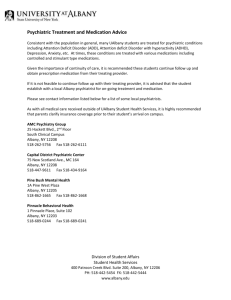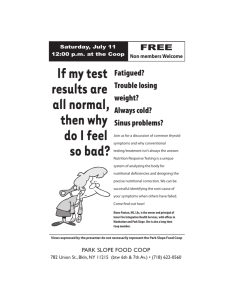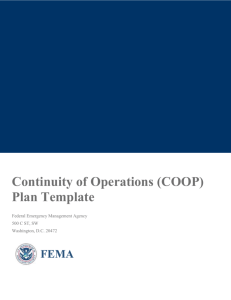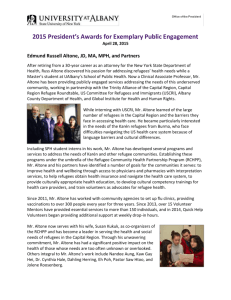All Hazards—Continuity of Operations Plan (COOP)
advertisement
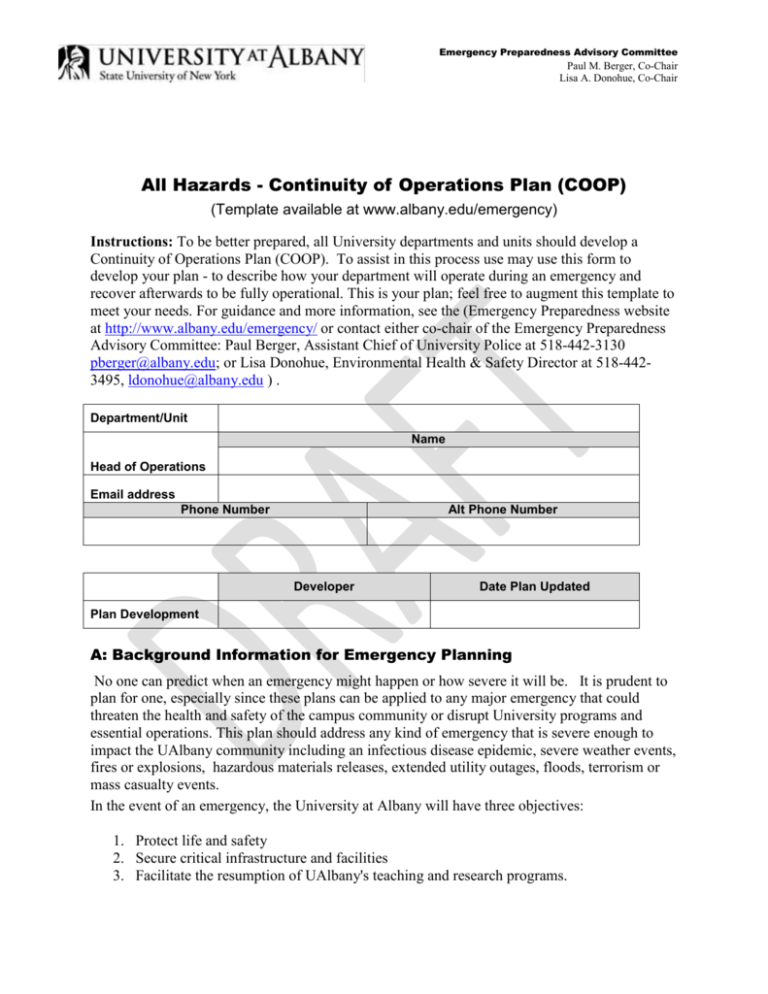
Emergency Preparedness Advisory Committee Paul M. Berger, Co-Chair Lisa A. Donohue, Co-Chair All Hazards - Continuity of Operations Plan (COOP) (Template available at www.albany.edu/emergency) Instructions: To be better prepared, all University departments and units should develop a Continuity of Operations Plan (COOP). To assist in this process use may use this form to develop your plan - to describe how your department will operate during an emergency and recover afterwards to be fully operational. This is your plan; feel free to augment this template to meet your needs. For guidance and more information, see the (Emergency Preparedness website at http://www.albany.edu/emergency/ or contact either co-chair of the Emergency Preparedness Advisory Committee: Paul Berger, Assistant Chief of University Police at 518-442-3130 pberger@albany.edu; or Lisa Donohue, Environmental Health & Safety Director at 518-4423495, ldonohue@albany.edu ) . Department/Unit Name Head of Operations Email address Phone Number Alt Phone Number Developer Date Plan Updated Plan Development A: Background Information for Emergency Planning No one can predict when an emergency might happen or how severe it will be. It is prudent to plan for one, especially since these plans can be applied to any major emergency that could threaten the health and safety of the campus community or disrupt University programs and essential operations. This plan should address any kind of emergency that is severe enough to impact the UAlbany community including an infectious disease epidemic, severe weather events, fires or explosions, hazardous materials releases, extended utility outages, floods, terrorism or mass casualty events. In the event of an emergency, the University at Albany will have three objectives: 1. Protect life and safety 2. Secure critical infrastructure and facilities 3. Facilitate the resumption of UAlbany's teaching and research programs. All Hazard Continuity of Operations Plan (COOP) Template University at Albany, SUNY B: Your Department’s Objectives Considering your department’s unique mission, briefly describe your teaching, research and service objectives (Additional pages may be added as needed): C: More Information Regarding Your Department Please note below information for your department’s contact. Name Phone Number COOP Contact Email address Dept. location(s) Please indicate below the principle nature of your department’s operations (check all that apply): Instruction Student life support Laboratory research Research support Other research Facilities support Administration Other (describe): ________________________________ D: Emergency Communication Systems All University employees are responsible for keeping informed of emergencies by monitoring news media reports, UAlbany’s web home page, and by email, text messages and phone alert messages (SUNY NY-Alert). To rapidly communicate with your employees in an emergency, we encourage all departments to prepare and maintain a call tree. Note below the system(s) you will use to contact your employees in an emergency. Departments should identify multiple communication systems that can be used for backup, after hours, when not on campus, or for other contingencies. Phone Email Text messaging Call tree Departmental web site Pager Instant messaging Other (describe): ____________________ Page 2 All Hazard Continuity of Operations Plan (COOP) Template University at Albany, SUNY E: Emergency Access to Information and Systems If access to your department’s information and systems is essential in an emergency, describe your emergency access plan below. This may include remote access (or authorization to allow remote access), contacting IT support, Blackboard, off-site data backup, backup files on flash drives, hard copies, “smart phones” and other handheld computers, or use of alternate email systems (e.g., Yahoo, Gmail). Identify what critical data and records are backed up, whether the back up is stored on-site or off-site. Simulate a failure scenario that tests the ability to recover “lost” critical data. Describe how your department will respond to the destruction of critical data. List essential functions that will need to have remote access to systems and individual’s authorized to perform temporary but critical “work from home”. F: Your Department’s Essential Functions Below list your department’s functions that are essential to operational continuity and/or recovery. Identify the position title which is responsible for each essential function. Identify primary personnel and alternate personnel and make sure that alternates are sufficiently cross-trained to assume responsibilities. Essential Function: Essential Position Title: Primary Alternate Second Alternate Primary Alternate Second Alternate People Responsible Phone Numbers Essential Function: Essential Position Title: People Responsible Phone Numbers Page 3 All Hazard Continuity of Operations Plan (COOP) Template University at Albany, SUNY Essential Function: Essential Position Title: Primary Alternate Second Alternate Primary Alternate Second Alternate Primary Alternate Second Alternate People Responsible Phone Numbers Essential Function: Essential Position Title: People Responsible Phone Numbers Essential Function: Essential Position Title: People Responsible Phone Numbers Sections F and G contain the list of your department’s key personnel and leaders - those responsible for the above essential functions. The Head of Operations and each primary person listed in an essential position are your department’s primary Essential Personnel. In an emergency, essential personnel are expected to report to work unless directed by supervisor or public safety authorities not to report for health and safety reasons. G: Your Department’s Leadership Succession List the people who can make operational decisions if the head of your department or unit is absent. Name Phone Number Alt Phone Number Head of Operations First Successor Second Successor Third Successor Page 4 All Hazard Continuity of Operations Plan (COOP) Template University at Albany, SUNY H: Key Internal (Within UAlbany) Dependencies All UAlbany departments rely on Information Technology, Payroll, Purchasing, Business & Finance, University Police, Human Resources and Facilities & Grounds. List below the other products and services upon which your department depends and the internal UAlbany departments or units that provide them. Dependency (product or service) : Provider (UAlbany department): Dependency (product or service) : Provider (UAlbany department): Dependency (product or service) : Provider (UAlbany department): Dependency (product or service) : Provider (UAlbany department): Dependency (product or service) : Provider (UAlbany department): I: Key External Dependencies List below the products, services, suppliers and providers upon which your department depends. We recommend that you encourage them to prepare continuity of operations plan. Dependency (product or service) : Primary Alternate Primary Alternate Supplier/Provider Phone Numbers Dependency (product or service) : Supplier/Provider Phone Numbers Page 5 All Hazard Continuity of Operations Plan (COOP) University at Albany, SUNY Dependency (product or service) : Primary Alternate Primary Alternate Supplier/Provider Phone Numbers Dependency (product or service) : Supplier/Provider Phone Numbers J: Mitigation Strategies Considering your objectives, dependencies and essential functions, describe below the steps you can take now to minimize the impact of various types of crises on your operations. For example, you may wish to stock up on your critical supplies and develop contingency work-at-home procedures. This may be the most important step of your emergency planning process. Formulation of your mitigation strategies may require reevaluation of your objectives and functions. K: Exercising Your Plan & Informing Your Staff Share your completed Plan with your staff. Hold exercises to test the Plan and maintain awareness. Note below the type of exercises you will use and their scheduled dates. Staff orientation meeting Emergency communication test Exercise Dates Call tree drill Off site information access test Tabletop exercise Unscheduled work at home day Staff Distribution Date Interdepartmental exercise Emergency assembly drill Other drill (describe): ___________________________________ L: Recovery Describe your plan to fully resume operations as soon as possible after the crisis has passed. Identify and address resumption/scheduling of normal activities and services, work backlog, resupply of inventories, absenteeism, the use of earned time off, and emotional needs. M: Special Considerations for Your Department Describe here any additional or unique considerations that your department may face in an emergency or in selecting a continuity facility. N: For Events Impacting the Region consider Home Emergency Planning for Individuals and Families Employees, students and their families should plan for any type of emergency that could impact them in their home, apartment or residence hall. Don’t wait—an emergency can occur at any time. Past experience has taught us that employees may not show up for work if they are concerned for the safety and security of their families. We recommend that your employees receive the following information, available on the HHS Pandemic website at http://www.pandemicflu.gov/health and the Ready.gov web link. Guide for Individuals and Families Family Health Information Sheet Emergency Contacts Form Planning Checklist for Individuals and Families Page 7 O: COOP Submission Thank you for completing your department’s All Hazards Continuity of Operations Plan (COOP). Please submit this Plan to your Dean or Vice President for approval and identification of essential positions within your department/unit. Dean/VP name: Title: Dean/VP signature: Date submitted: Send an electronic copy of this completed COOP template to emergencypreparedness@albany.edu . Page 8

